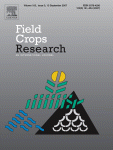Ver ítem
- xmlui.general.dspace_homeCentros Regionales y EEAsCentro Regional Buenos Aires NorteEEA PergaminoArtículos científicosxmlui.ArtifactBrowser.ItemViewer.trail
- Inicio
- Centros Regionales y EEAs
- Centro Regional Buenos Aires Norte
- EEA Pergamino
- Artículos científicos
- Ver ítem
Crop management affects dry-milling quality of flint maize kernels
Resumen
Dry-milling performance of maize (Zea mays, L.) kernels primarily depends on their hardness. The flint type is harder than the dent and semi-dent maize, yielding a higher proportion of big endosperm pieces in the mill. Nevertheless, crop growing conditions could modify milling properties. The objective of this work was to analyze the effect of different crop environments and management practices on dry-milling quality of flint maize kernels. Two
[ver mas...]
Dry-milling performance of maize (Zea mays, L.) kernels primarily depends on their hardness. The flint type is harder than the dent and semi-dent maize, yielding a higher proportion of big endosperm pieces in the mill. Nevertheless, crop growing conditions could modify milling properties. The objective of this work was to analyze the effect of different crop environments and management practices on dry-milling quality of flint maize kernels. Two orange-flint hybrids from different eras of breeding differing in flint type expression and grain yield potential were evaluated. They were grown at three different locations of the Argentina's main maize-production area under different sowing dates, plant densities, and fertilization rates during two growing seasons. Crop post-silking growth, grain yield and its components (kernel number and weight), kernel size and hardness-associated properties (test weight, percent floaters and milling ratio), and flaking-grit yield were analyzed. Most of observed differences in physical properties of kernels, particularly for the high-yielding new hybrid with unstable flint expression, were associated with the source–sink ratio established during the post-silking period (explored range from 154 to 617 mg kernel−1). This variable mainly results from changes in crop growth during that period. Increases in weight per kernel improved hardness-associated properties. High crop grain yields together with top dry-milling quality were achieved when the new high-yielding hybrid was cropped with an appropriated crop management.
[Cerrar]

Autor
Fuente
Field crops research 122 (2) : 140-150. (May 2011)
Fecha
2011-05
Editorial
Elsevier
ISSN
0378-4290
Formato
pdf
Tipo de documento
artículo
Palabras Claves
Derechos de acceso
Restringido
 Excepto donde se diga explicitamente, este item se publica bajo la siguiente descripción: Creative Commons Attribution-NonCommercial-ShareAlike 2.5 Unported (CC BY-NC-SA 2.5)
Excepto donde se diga explicitamente, este item se publica bajo la siguiente descripción: Creative Commons Attribution-NonCommercial-ShareAlike 2.5 Unported (CC BY-NC-SA 2.5)

